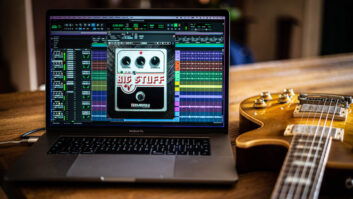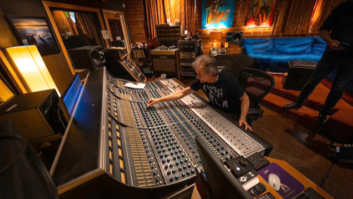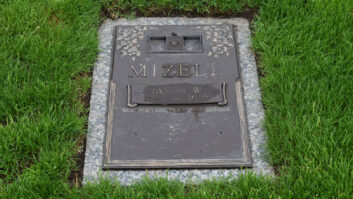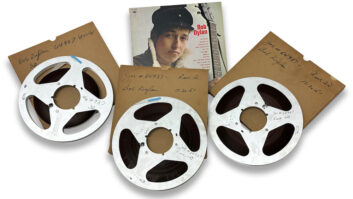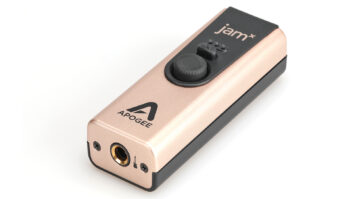
Apogee Electronics’ Big Ben is a revolutionary master digital clockthat does much more than preclude clicks and pops from tainting youraudio tracks. Unlike other Word Clock distribution boxes that achieveonly subtle reduction in jitter artifacts, Big Ben will make yourconverters sound dramatically warmer and smoother. Another bonus: BigBen can even perform digital audio format conversions.
Big Ben owes its impressive clocking performance to proprietarytechnologies: Apogee’s Direct Digital Synthesis process — anall-digital alternative to traditional phase-lock loop circuitry— generates clock frequencies with virtually immeasurable jitter.When synched to an external reference, Big Ben uses Apogee’s AdaptiveLoop Filtering to recondition the clock source and reduce jitter. (Ifound the improvement here to be audible, but subtle.) Thanks toSureLock technology, Big Ben continues to output clock signals at thelast valid frequency received by an external reference signal thatsubsequently drops out, purportedly guaranteeing a fail-safe lock.
I/O AND SUPPORTED FORMATS
All of Big Ben’s I/O connectors are found on the unit’s rear panel.These include AES/EBU inputs and outputs (two each, for a total offour), S/PDIF coaxial and Toslink optical I/O, and one video/Word Clockinput and six Word Clock outputs on BNC connectors. Big Ben provides aslot for an optional card to accept emerging formats; a FireWire I/Ocard ($695) will be available by year’s end. An IEC receptacle roundsout the rear panel.
Big Ben’s AES/EBU I/O supports both single- and double-wire formatsand sampling rates up to 192 kHz (and as low as 44.1 kHz in single-wiremode). The S/PDIF co-ax jacks accommodate 44.1 to 192kHz rates. TheToslink optical connectors support S/PDIF optical, ADAT, S/MUX 2 andS/MUX 4 formats at up to 192kHz rate. Pull-up and pull-down rates areavailable when Big Ben is synched to its internal clock or an externalvideo signal. Big Ben constantly sends digital black out all audiooutput jacks when the unit is slaved to its internal clock. When lockedto an external clock that’s embedded in a digital audio signal, Big Benroutes that signal (with clock) to all digital audio outputs andconverts between AES/EBU, S/PDIF, optical and option-card formats.
Big Ben’s internally terminated video/Word Clock input will accepteither TTL Logic (Word Clock) or video black burst (PAL, NTSC orB&W) signals, depending on the unit’s front-panel settings. Two ofBig Ben’s six Word Clock outputs can transmit a clock at fractions ormultiples of the sampling rate; available rates include fs/4 (¼times the sampling frequency), fs/2, fs ×1, fs ×2, fs ×4and fs ×256. Intuitive front-panel controls make the selection ofdigital audio formats and clock rates a breeze. Also on the front panelare a series of LEDs that indicate whether each of the six Word Clockoutputs sense over-termination or no termination on their slaveddevice. I found this feature to be somewhat a white elephant, however,when used with converters that don’t comply with the 75-ohm terminationstandard.
SMOOTH OPERATOR
Before I began any critical-listening tests, I knew my digital audioconverters were performing much better when synched to Big Ben, becausemy recordings sounded extraordinarily warm and smooth. The acid test,however, was a blindfolded comparison of two A/D converter sets (ApogeeRosetta 96 and MOTU HD192) using various clocking schemes. For thistest, I made multiple stereo recordings of acoustic guitar to DigitalPerformer with DPA 4011 mics and a Millennia HV-3D/8 preamp, andmonitored the results through a Benchmark DAC-1, Hafler P3000Trans•Nova power amp and D.A.S. Monitor-8 monitors.
The sonic differences between recordings made with the HD192 A/Dswhen slaved to Big Ben’s internal clock vs. using the HD192’s internalclock were simply astounding. Big Ben’s clock made the overall sounddramatically warmer (i.e., less edgy), the high end far sweeter and thespectral balance noticeably smoother. Trust me, this is not simply theramblings of an obsessed engineer: Even my wife (who is not an audioperson) could identify the recording made with Big Ben’s clock!
Removing Big Ben from the equation for a moment, an A/B comparisonof my Rosetta 96’s converters to the HD192’s A/Ds (with each converterset using its internal clock) revealed the Rosetta to be a bit warmerand smoother-sounding. The recording made with the HD192 slaved to BigBen’s internal clock, however, sounded a tad silkier in the highs (yeta little less open and flat, spectrally) than that made using theRosetta (which necessarily was synched to its internal clock, as itdoes not have Word Clock input). Yet another A/B test revealed BigBen’s clock to be clearly superior to Rosetta’s.
Big Ben is competitively priced at $1,495 list. This groundbreakingbox gets my highest recommendation. You’ll be amazed!
Apogee Electronics, 310/915-1000, www.apogeedigital.com.


